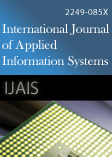
- Oloyede Muhtahir O. and Addoyin Adeyinka O. and Adewole Kayode S. 2013. Fingerprint Biometric Authentication for Enhancing Staff Attendance System. International Journal of Applied Information Systems. 5, 3 (February 2013), 19-24. DOI=http://dx.doi.org/10.5120/ijais450867
-
@article{10.5120/ijais2017451568, author = {Oloyede Muhtahir O. and Addoyin Adeyinka O. and Adewole Kayode S.}, title = {Fingerprint Biometric Authentication for Enhancing Staff Attendance System}, journal = {International Journal of Applied Information Systems}, issue_date = {February 2013}, volume = {5}, number = {}, month = {February}, year = {2013}, issn = {}, pages = {19-24}, numpages = {}, url = {/archives/volume5/number3/426-0867}, doi = { 10.5120/ijais12-450867}, publisher = { xA9 2012 by IJAIS Journal}, address = {} } -
%1 450867 %A Oloyede Muhtahir O. %A Addoyin Adeyinka O. %A Adewole Kayode S. %T Fingerprint Biometric Authentication for Enhancing Staff Attendance System %J International Journal of Applied Information Systems %@ %V 5 %N %P 19-24 %D 2013 %I xA9 2012 by IJAIS Journal
Abstract
In electronics memories are the widely used elements. As the transistor size shrinks multiple-bit upset (MCUs) are increasing due to radiation effects in memories. This affects the reliability of memories. Interleaving and built-in current sensors (BICS) have been success in the case of single event upset (SEC). The process is taken one step further by proposing specific error correction codes to protect memories against multiple-bit upsets and to improve yield have been proposed. The method is evaluated using fault injection experiments. The results are compared with known techniques such as Hamming codes. The proposed codes provide a better performance compared to that of the hamming codes in terms of Single Event Upset. In the case of the Multi Bit Upset it provides better coverage in error deduction and correction schemes.
References
- BioLink 2006. Time and attendance, Retrieved 11th December, 2011 from http://www. m3biometrics. co. uk/Portals/2/downloads/BioTime_Time_and_Attendance. pdf.
- Graevenitz, G. A. 2003. Introduction to fingerprint technology. Retrieved 10th December, 2011 from http://info. bioenabletech. com/training/fingerprint/Introduction%20to%20Fingerprint. pdf.
- Hashim, A. Y. 2011. An enduring relationship between biometric traits and security systems, International Journal of Research and Reviews in Information Security and Privacy, 1(1), pp. 1-6.
- InfoTronics, Inc. 2008. Biometrics: Advantages for employee attendance verification, Michigan: Farmington Hills. Retrieved 11th November, 2011 from www. mwtime. com/biometrics. pdf.
- Lease, D. R. 2005. Factors Influencing the Adoption of Biometric Security Technologies. Information Technologies and Security Managers. Retrieved 15th August, 2011 from http://drdavidlease. com/uploads/David_Lease_Dissertation. pdf.
- Sandhu, P. S, Kaur, I. , Verma, A. , Samriti, J. and Singh, S. 2009. Biometric methods and implementation of algorithms. International Journal of Electrical and Electronics Engineering, 3(8).
- Yuihotakaishi, 2011. Attendance Monitoring System Using Biometrics for Security Staff, studymode Inspiring. Retrieved 9th June, 2012 from http://www. studymode. com/essays/Attendance-Monitoring-System-Using-Biometrics-For-732262. html.
- Kadry, S. and Smaili, M. 2010. Wireless Attendance Management System Based on Iris Recognition. Scientific research essay. Retrieved 15th October, 2012 from http://academicjournals. org/sre/PDF/pdf2010/18Jun/Kadry%20and%20Smaili. pdf.
- Mycroft, R. 2011. Performance and Strategy Scrutiny Committee. Staff productivity. Retrieved 16th November, 2012 from http://www. shropshire. gov. uk/committee. nsf/0/5994B308D8ECC9B48025788C004A5A54/$file/Item%207%20-%20Staff%20Productivity. pdf.
- Clavereau, M. (2011). Absence: time to tackle the root causes. Retrieved 9th December, 2012 from http://www. hrmagazine. co. uk/hro/news/1018998/absence-tackle-root-causes.
- Tuller, M. , Dhawan, A. , Simon, B. , Lee, K. , and Ward, D. 2006. Biometrics: Strategic Technology Analysis Technology Foresight Dynamics Group 4 White Paper.
- Bistarelli, S. , Boffi, G. , Rossi, F. , 2003. Computer Algebra for Fingerprint Matching. Retrieved 11th July, 2012 from http://dl. acm. org/citation. cfm?id=1764265.
- Jain, A. , Hong, L. , Pankanti, S. , Bolle, R. , 1997. An Identity Authentication System Using Fingerprints. Retrieved 10th June, 2012 from http://biometrics. cse. msu. edu/Publications/Fingerprint/JainEtAlIdentityAuthUsingFp_ProcIEEE97. pdf.
- BioElectronix, Inc. 2012. Powerful & easy to use Time & Attendance Software. Retrieved 11th July, 2012 from http://www. bioelectronix. com/ec_50. html.
- Liz, P. 2012. Biometric Benefits; Fingerprint readers reduce inventory shrink and eliminate payroll fraud. Retrieved 12th December, 2012 from http://www. stores. org/STORES%20Magazine%20April%202012/biometric-benefits#. UMpT1pG31d8.
- Saunders, M. , Lewis, P. , Thornhill, A. 2007. Research Methods for Business Students (4th ed. ), Pitman publishing, ISBN: 978–0–273–7168670.
- Stake, R. E. 2010. Qualitative Research, Studying how things work. Retrieved 24th July, 2012 from http://books. google. co. uk/books?hl=en&lr=&id=wwwVpKNFoxEC&oi=fnd&pg=PR1&dq=Qualitative+Research+Studying+How+Things+Work+Robert+E. +Stake&ots=MaeZGsfzTp&sig=CPnqbO2ns.
- Neuman, W. L. 2007. Basics of social Research, Qualitative and Quantitative Approaches, Publisher's Design and Production Services, Pearson Education Inc. ISBN: 0-205-48-13.
- NSTCS, 2006. Biometrics Technologies. National Science and Technology Council Subcommittee on Biometrics. Retrieved 2nd July, 2012 from http://techbiometric. com/downloads/view-document-details/biometrics-foundation documents
- Jiexun L. , Wang . A. and Chen H (2011). 'Identity matching using personal and social identity features'; 13: 101 – 113
- Capoor S. (2006). 'Biometrics as a Convenience Security', Business story December 1, 48, 50. Retrieved 16th October, 2012 from http://proquest. umi. com/pqdweb?index=0&did=1182578721&SrchMode=1&sid=7&Fmt=6&VInst=PROD&VType=PQD&RQT=309&VName=PQD&TS=1304031215&clientId=13314.
- Dubin, C. (2011). 'Biometrics: Hands Down', ID management. Security, February 1, 52, 54. Retrieved 13th November 2011from http://proquest. umi. com/pqdweb?index=0&did=2277161341&SrchMode=1&sid=2&Fmt=6&VInst=PROD&VType=PQD&RQT=309&VName=PQD&TS=1304030671&clientId=13314 .
- Kreimer . S. (2010). 'Matching the Right Patient to the Right Record'. Hospitals & Health Networks,November 1, 12. Retrieved 17th December 2011 from http://proquest. umi. com/pqdweb?index=0&did=2212480041&SrchMode=1&sid=1&Fmt=6&VInst=PROD&VType=PQD&RQT=309&VName=PQD&TS=1304102414&clientId=13314.
- Zalud, B. (2010). 'Poor Sister No More: Access Enters Spotlight Again'. Journal of Access management Security, August 1, 42,44-45. Retrieved 28th April 2011 from http://proquest. umi. com/pqdweb?index=0&did=2114680931&SrchMode=1&sid=18&Fmt=6&VInst=PROD&VType=PQD&RQT=309&VName=PQD&TS=1304034968&clientId=13314
Keywords
Biometric, verification, staff attendance, telecommunication, productivity
 10.5120/ijais12-450867
10.5120/ijais12-450867
